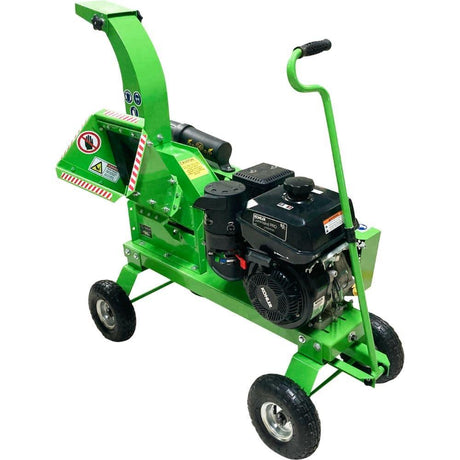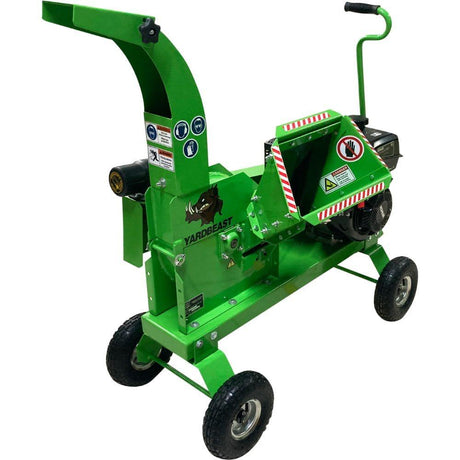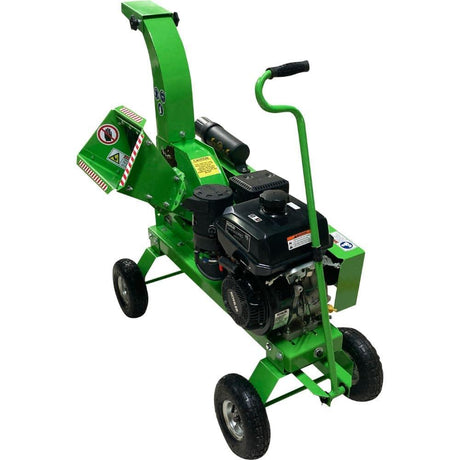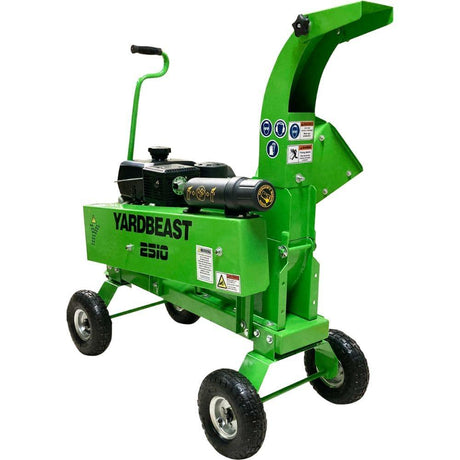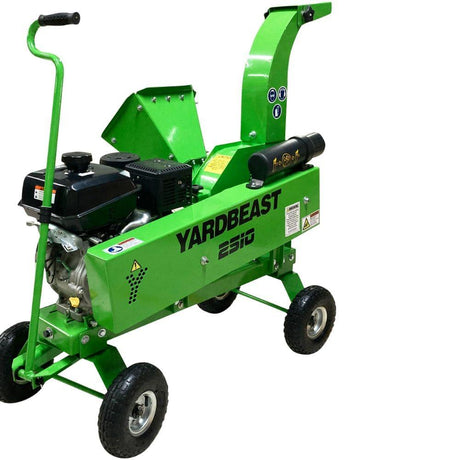- 7% off
2 Inch Wood Chipper: Lightweight Power for Everyday Yard Cleanup
Looking for a compact tool that simplifies yard maintenance without overcomplicating the process? A 2-inch wood chipper might be exactly what you need. These small but capable machines are designed to handle a huge amount of branches, twigs, and light brush up to 2 inches thick—making them ideal for homeowners, gardeners, and DIYers who need reliable performance in a manageable package.
In this guide, we’ll explore what 2-inch chippers can really do, how they compare to both larger and smaller models, and how to choose the right one for your needs. We’ll break down essential features, provide practical tips, and share expert advice to help you make the most of your chipper investment.
Introduction to 2-Inch Wood Chippers
After pruning your trees or cleaning up storm debris, it doesn’t take long for yard waste to pile up. That’s where a 2-inch wood chipper steps in. Built for branches and garden waste up to 2 to 2.5 inches in diameter, these compact machines turn clutter into useful mulch or manageable piles—without the noise, bulk, or price tag of commercial models. These machines provide easy access to efficient yard cleanup without the need for larger, more complicated equipment.
Most residential trees (like maple, fruit trees, pine, and birch) produce branches well within this size range, so a 2-inch chipper covers the majority of light to moderate yard cleanup tasks. It’s the perfect middle ground for folks who find electric shredders too weak and commercial chippers too much.
What Are 2-Inch Wood Chippers?
Purpose-built for everyday yard waste: These chippers are optimized to handle a huge variety of yard waste, including twigs, hedge trimmings, softwood limbs, and small branches up to 2 inches in diameter. While they’re not built for dense hardwood logs, they excel at managing common garden debris efficiently.
Electric vs. Gas Models:
- Electric 2-inch chippers are compact, quiet, and maintenance-friendly. Most run on standard household current and feature 14–15 amp motors. They’re perfect for small yards or weekend yard work. However, they may struggle with thick or wet materials. Electric models provide easy access to efficient yard cleanup without the need for more complicated gas models.
- Gas-powered options, while less common in the 2-inch range, offer more torque for dense or irregular branches. If you’re working off-grid or need more muscle, a lightweight gas model (typically 4–6.5 HP) can get the job done.
Designed for maneuverability:
Most 2-inch chippers weigh less than 100 pounds, with many under 70 lbs. They often come with sturdy wheels and handles, making them easy to move around your property—even on uneven terrain. Despite their compact size, these machines can handle a huge amount of yard waste efficiently.
Built to last:
Despite their smaller size, quality 2-inch chippers include features like hardened steel blades, steel hoppers, and powder-coated frames. When properly maintained, these machines can serve you for years. The long-term benefits of these durable machines are huge, as they can handle substantial branches and debris efficiently.
Why Choose a 2-Inch Model?
- Perfect for light-to-medium yard work: A 2-inch chipper can handle about 80–90% of typical yard waste without overkill. It’s ideal for suburban homeowners, small gardens, and seasonal trimming.
- More affordable and accessible: These machines are generally lower cost than 3-inch or higher-capacity models, both in price and maintenance. If you’re not dealing with large limbs regularly, there’s no reason to pay more. They also provide easy access to efficient yard cleanup without the need for larger, more complicated equipment.
- Compact and easy to store: Many models stand under 4 feet tall and less than 2 feet wide. That means they’ll easily fit in your garage, garden shed, or even a large storage cabinet.
- Eco-friendly mulch creation: The output chips are just the right size for mulching flower beds, creating compost starter, or building natural walkways. You can skip the dump run and repurpose yard waste instead.
- Beginner-friendly design: Most units offer push-button starts (electric) or simple pull-starts (gas), along with intuitive safety features and easy controls. Even first-time users can operate them confidently.
- Minimal maintenance: Electric models require little more than blade checks and occasional cleaning. Gas models need basic oil changes and air filter cleaning, but fewer moving parts mean fewer surprises.
Key Features and Benefits of 2-Inch Wood Chippers
Power and Performance
- Engine ratings: Most electric 2-inch chippers operate at 14–15 amps, providing around 1.5–2.5 HP equivalent. Gas models in this category offer 4–6.5 HP and deliver more torque, useful for hardwood or longer sessions.
- Blades: Look for dual-edged, reversible steel blades. These allow you to extend blade life before sharpening or replacing. Quality blades can chip 50–100 lbs of material per hour, depending on moisture and feed quality.
- Feed capacity: While 2-inch models aren’t built for gnarled or knotted limbs, they perform well with straight branches and trimmed yard waste. Despite their compact size, these machines have huge capabilities in handling substantial yard debris efficiently.
Pro tip: Feed smaller, dry branches for best results. Wet or leafy material should be fed gradually to avoid jams or bogging.
Feeding System and Discharge
- Gravity-fed chutes: Standard on most models and work well for straight branches. Some models include push paddles or self-feeding hoppers to simplify use.
- Discharge chutes: Often direct mulch into a bag or at ground level. Ensure the discharge is adjustable or at a convenient height for your setup (wheelbarrow, tarp, etc.).
Field tip: Trim branches to 2–3 feet lengths and remove excessive foliage for easier feeding and smoother operation.
Chip Output and Mulch Quality
- Chip size: Expect mulch particles between 1 and 2 inches, depending on blade sharpness and material. Perfect for flower beds, garden paths, or moisture retention layers.
- Volume: A 2-inch chipper can produce 4–8 cubic feet of mulch per hour. While smaller than heavy-duty models, it’s still plenty for weekend cleanup or monthly maintenance.
- Money-saving potential: With mulch selling at $30–$50 per cubic yard, your chipper pays for itself quickly—especially if you maintain a garden or need routine landscaping upkeep.
Ease of Use and Safety
- Controls: Electric models offer one-touch starts, while gas models may include choke levers and manual fuel shutoffs. Most are straightforward to operate, even for beginners.
- Safety features: Hopper flaps to block kickback, emergency shut-offs, clear start/stop labels, and feed paddles are common on many models.
- Portability: Many weigh between 45 and 90 pounds and include ergonomic handles, wheels, and low-profile frames for easy storage and movement.
Safety tip: Wear gloves, glasses, and ear protection. Always power down before unclogging or checking inside the hopper.
Use Cases and Scenarios
Homeowners and Gardeners
- Weekend warriors: Ideal for trimming fruit trees, clearing bushes, or prepping seasonal mulch. Lightweight, efficient, and easy to manage solo.
- Urban and suburban spaces: Small enough to fit through gates, navigate tight spaces, and run quietly in residential areas.
- Cost-effective landscaping: Save hundreds per year by producing your own mulch on-site. No more paying for yard waste pickup or bagging debris.
DIYers and Hobby Users
- Composting advantage: Wood chips make an excellent base layer for compost piles, improving airflow and balancing green materials.
- Seasonal cleanup: Whether it’s spring pruning or autumn leaves, a 2-inch chipper keeps your yard tidy without the hassle of big machinery.
Bonus tip: Some models can handle pine cones and dry plant stalks—just avoid wet or stringy material like vines or fresh palm fronds.
Real-Life Advice and Maintenance Tips
- Case example: A gardener in a small town uses their electric 2-inch chipper weekly for tree trimmings and plant waste. After 2 years, they’ve saved over $400 on mulch and yard waste disposal.
- Pro tip: Keep a spare blade and Allen wrench handy. Dull blades reduce chip quality and can strain the motor. Regular cleaning of the discharge area prevents clogging and overheating.
- Storage insight: Cover your chipper when not in use, or store it indoors to protect against rust and weather damage—especially with electric units.
Comparing 2-Inch to Larger Chippers
- Simplicity over power: If you rarely deal with thick limbs, a 2-inch chipper is faster to set up, easier to clean, and better suited to lighter materials.
- More compact, more nimble: Larger 3-inch chippers weigh 100+ lbs and require more room. If space is tight or you need to move the unit often, a 2-inch model is far more manageable.
- Price vs. performance: You can expect to pay less than half the price of a 3-inch chipper. For occasional or seasonal use, this makes a 2-inch machine the smarter choice.
Buying Tips for 2-Inch Wood Chippers
- Know your branch size and how often you’ll use the machine
- Choose electric for quiet operation and minimal maintenance
- Select gas if you’re dealing with denser wood or want off-grid operation
- Look for steel blades, metal hoppers, and solid wheel designs
- Compare warranty options and check availability of spare parts
- Prioritize ease of storage and maneuverability
- Read user reviews to verify chip quality and long-term performance
- These machines provide easy access to efficient yard cleanup without the need for larger, more complicated equipment.
FAQ: 2-Inch Wood Chippers
What can they handle?
- Straight branches up to 2 inches
- Softwoods, dry hardwoods, pine cones, and trimmings
- Light hedge cuttings, twigs, and dry plant waste
- These machines provide easy access to efficient yard cleanup without the need for larger, more complicated equipment.
How much maintenance is needed?
- Blade sharpening every 10–15 hours
- Clean hopper and discharge after each use
- Check cord (electric) or spark plug/oil (gas) regularly
Are they good for mulch? Yes! They create coarse to medium chips perfect for garden beds, walkways, and erosion control.
What materials should I avoid?
- Wet or stringy vines
- Large bundles of leaves
- Knotted or forked limbs unless trimmed
What safety gear do I need?
- Gloves, goggles, and hearing protection
- Avoid loose clothing near the hopper
- Keep kids and pets at a safe distance
Final Thoughts
A 2-inch wood chipper is a perfect match for homeowners who want yard tools that are simple, effective, and easy to manage. These machines shine in everyday situations—turning garden waste into useful mulch without the hassle of large, noisy equipment. Despite their smaller size, these chippers offer huge capabilities in handling substantial branches and debris.
Whether you’re tidying trees, trimming hedges, or composting waste, a 2-inch chipper keeps your space looking sharp and saves you money long-term. For the best experience, choose a model with durable parts, easy feeding, and strong customer reviews. Invest wisely, use it often, and enjoy a cleaner, more sustainable yard—all season long.

